A stitch in time: St. Augustine man keeps sewing machines going, even after 120 years
John Niles sometimes puts a simple sign — white background, black letters — outside his house in a woodsy subdivision in the St. Augustine suburbs. SEWING MACHINES, it reads.
No kidding: Inside his garage on a recent day, there were at least 30 sewing machines there for sale, repair, trade or parts. Most of them are 70 to 120 years old with intricate etching on metal parts and ornate gold illustrations all over them — a far cry from the utilitarian beige plastic machines that followed them.
Many of those are still stored in their original curved wooden boxes or are tucked into elaborately carved tables with metal foot treadles, which themselves are almost a piece of art.
Niles, who is 72, came to them in the early days of the pandemic. Needing a diversion, he began tinkering with old Singers, Whites, Westinghouses, Nationals and Wheeler & Wilsons, most of which weren't operable — not many people these days know how to fix them ― but which, with some attention, can be brought back to thriving life.
Some of the later models came wired for electricity, and others were retrofitted along the way. But a good number of them are still powered by foot treadles, knee pedals or hand wheels.
Niles has spent a lifetime fixing things, and he seems endlessly enthusiastic about these elegant pieces of machinery. They're not just collector's items or pretty things you put on a shelf, though that's what some people do. With a little attention, he says, they can work and work well, even after generations of use.
“They’re from another time and they’re just so well-made, the craftsmanship is incredible," he said. "What these guys were doing 100 years ago, it’s amazing.”
On this day, the typewriters fill the floor of his garage. But he needs them moved to the side by the end of the day so he can get his car (a mint 2011 Mercury Grand Marquis that he works on himself) into the garage at night. So most of the sewing relics were placed atop wooden stands he made that roll on wheels from cast-off office chairs.

Those wheels are needed: Though much-prized Singer Featherweights, made of cast aluminum, are pretty lightweight, most of the vintage machines are heavy, made of cast iron. Made to last.
Going to Africa?
Niles is pleased that four of the vintage machines he's repaired, powered by foot pedals, could be soon going to an impoverished area of Africa, where they'll be able to be used without the need for electricity.
Mary Soha, a layperson at the Catholic diocese in St. Augustine, is hoping to send them to help support people in a village where other she and other parishioners have provided funding for a building with a solar panel and a pump for water.
The machines — even though they're 100 years old or more — could be useful to those living there, where electrical service is spotty at best. "They were so well-built, if you know how to use the different foot pedals they can do more than the modern machines can do, still," Soha said.
The Rev. Martin Ibeh, parochial vicar at Our Lady of Good Counsel in St. Augustine, said the center where the sewing machines would go is an attempt to help elderly and disabled villagers in a remote section of Nigeria, his native country, to become self-sufficient. The building is already staffed by two nuns, one trained as a nurse, so it serves as a health care center too.
Ibeh said poor people in the area, if disabled or elderly, are often forced to beg without a government support system in place. He'd like to see some disabled women in the village become proficient at sewing on those old machines.
“They can be trained to learn some handiwork in the community, so those sewing machines will help them to be self-reliant," he said. "When you have nothing, anything can be useful."
'Another 100 years'

Niles moved to St. Augustine in 2003 to be close to his parents, who needed help. He grew up in Centerville, N.J., a quaint place back then, complete with a blacksmith's shop.
At around age 10, he began building and tinkering with motorbikes, then spent a career mostly in construction as a carpenter, electrician and construction supervisor. He also made a lot of custom furniture; later he built the furniture in the St. Augustine house he shares with his brother, Denis.
“I always had a fascination with stuff, you know," he said.
However, neither he nor his brother are computer whizzes or social media experts, he says, but he does sell his machines on a Facebook Marketplace account under Denis' name.
Niles says he's found numerous sewing buffs through this work, and while many computerized sewing machines are now available (he doesn't work on them), there's still a "cult following" of people doing it the old way.
Family and consumer scienes: First Coast homemaker clubs show how home economics skills are still important
He's got some connections to get parts that he needs, but he sometimes he makes his own, filing and hand-shaping homemade springs and knobs — whatever it takes to get the old machines working again.
He said people often tell him that their grandmothers, or great-grandmothers, used to use the very machine they're bringing in for repair.
Niles likes that link to the past, at one point conjuring up the image of someone in the Oklahoma Territory, waiting for the machine to arrive by freight so it could be put to steady use.
Clothing wasn't disposable then, for most. It had to last.
“Back 100 years ago you needed a sewing machine, in the village or in the household or on the farm, to make and mend clothing," he said. “Today it’s a hobby. Back then it was a must-have.”
Inside his garage, he stopped to admire a particularly elaborately decorated Singer from the early 1920s. He smiled. "That’ll sew a perfect stitch for another 100 years," he said.
This article originally appeared on Florida Times-Union: Vintage Singer sewing machines get new life in St. Augustine

